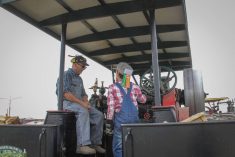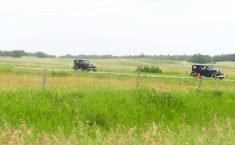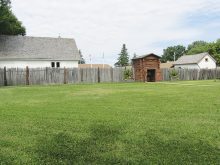Before the coming of the railroad and the construction of roads, the two-wheeled “Red River cart” was the main method of land transportation in what was to become Manitoba.
Due to the history and importance of such carts passing through the area, Ray Pettinger, a Shoal Lake senior with a passion for crafting turned his attention on the creation of a Red River cart.
The craftsmanship highlights its historic importance to the Indigenous and Métis peoples, traders, hunters, missionaries, Royal Canadian Mounted Police, surveyors, and settlers. Plains First Nations even referred to the Métis as “half-wagon, half-man.”
Read Also

Manitoba launches CWD tracking tool
A newly launched digital dashboard allows hunters to track where chronic wasting disease has been confirmed in Manitoba
“The Shoal Lake and St. Lazare areas have old, rutted trails, which pass through the south end of Shoal Lake and on to Fort Ellice, a Hudson’s Bay Company trading post, near St. Lazare,” Pettinger said.
“These trails, originally carved by this type of cart, continue on to Fort Carlton and eventually end at Fort Edmonton. All told from the Red River settlement to Fort Edmonton it was a distance of 1,440 kilometres (900 miles) connecting fur trading posts and buffalo hunting grounds.”
The first carts used were quite small. Larger, better-constructed carts made their way onto the transportation scene around the start of the 19th century, possibly by 1803, when improved wheels were being manufactured. These larger, spoked wheels were dished, or curved inward, and provided greater stability and handling.
Red River carts were noisy (emitting a screeching noise caused by dry axles, a necessity to extend the life of an axle) but versatile carts that criss-crossed what are now the Prairie provinces, North Dakota, Montana and Minnesota during much of the 19th century.
Made entirely of wood, the lightweight vehicle was cheap to build, and was a functional conveyance that helped in the development of Canada’s West through the movement of furs and goods used in the day-to-day lives of settlers. The versatile carts were pulled by a single horse, pony, or ox, hauling between 300 and 450 kilograms of freight.
“Being made entirely out of wood, carts could be repaired with what was on hand. Because of availability, poplar wood with a fir axle was the popular choice, however, other woods such as maple, oak, ash or elm may have also been used,” Pettinger said. “A supply of parts would have been available in the roadside tree bluffs, with the parts bound together with rawhide (shaganappi), sisal rope and twine. The advantage of rawhide is the fact that when tied wet it shrinks on drying, making a tight connection.”
Pettinger began his build back in May and finished the project in October, using his garage as his workshop. Wheel hubs and the axle were completed first, followed by the chassis, a six-foot-long, four-foot-wide, three-foot-high structure.
“The material used is courtesy of the dead fall poplar trees found along the Rural Municipality (RM) of Yellowhead ditches,” Pettinger said. “The floor of rough-cut spruce slabs completed the project.”
Pettinger added that throughout the process the 51-inch wheels with six spokes were formed from half-inch by 2.5-inch poplar strips glued and clamped together around a steel rim, which is not part of the wheel.
“Carts hauling heavier loads would have had wheels with 12 spokes each,” said Pettinger, who has no plans for the cart at the moment.
“Being an educational piece, which formed an important part of Manitoba’s and Western Canada’s heritage, it’s a special creation from a personal standpoint.”
Enjoying working with wood, Pettinger’s projects have included a variety of household furniture, a violin, bagpipes, hundreds of bird boxes, and an airplane, to name a few items of interest.
History is a family interest, as his wife Barbara (Barb) was involved in the Mounted Police Museum (located at Lakeview Park) and its importance to the community and the municipality since she joined the board in 1994. Up until January 2021, she served as the secretary-treasurer, and now solely holds down secretary duties.
While the Red River cart has its place in history, so does the North West Mounted Police (NWMP). Newly formed in 1874, destined to become Canada’s world-famous Mounties, their trek west laces western settlement with a form of law enforcement as unique as their scarlet tunics.
Manitoba’s official Mounted Police Museum is a replica of the original NWMP barracks, built at the south end of Shoal Lake in 1875.
With settlers reaching the area, the community of Shoal Lake was established in 1884, and moved to its current location at the lake’s north side in 1885 to coincide with the building of the Manitoba & Northwestern Railroad (now CPR). The community incorporated as a village on Jan. 12, 1909, and then changed to town status on Oct. 10, 1997.















